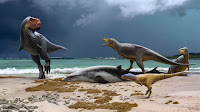 |
in Longrich, Isasmendi, Pereda-Suberbiola & Jalil, 2023. Artwork: Andrey Atuchin |
Abstract
The end of the Cretaceous saw the evolution of endemic dinosaur faunas on different landmasses, driven by continental fragmentation. Understanding the evolution of these biogeographic patterns is important for understanding the evolution of Mesozoic ecosystems. However, the faunas of the southern land masses remain understudied relative to the intensively sampled dinosaur faunas of western North America and Asia. In particular, the latest Cretaceous of Africa remains largely unknown, with only a handful of taxa reported so far, including titanosaurian sauropods, the lambeosaurine Ajnabia odysseus, and the large abelisaurid theropod Chenanisaurus barbaricus. We report two new abelisaurid fossils from the upper Maastrichtian phosphates of the Ouled Abdoun Basin, in northern Morocco. The first is the tibia of a medium-sized abelisaurid from Sidi Chennane, with an estimated length of ∼5 m. The tibia has a strongly hooked cnemial crest resembling that of the South American Quilmesaurus and Aucasaurus. The highly rugose bone texture suggest the animal was mature, rather than a juvenile of the larger Chenanisaurus. The second is a small right second metatarsal from Sidi Daoui,. The metatarsal measures 190 mm in length, suggesting a small animal, ∼2.6 m in length. The metatarsal shows strong mediolateral compression, a feature present in noasaurids and some early abelisaurids, but absent in most Late Cretaceous abelisaurids. It is distinct from other abelisauroids in the strong constriction and bowing of the shaft in lateral view, and the medial curvature of the bone in anterior view. Bone texture suggests it comes from a mature individual. The small size, gracile proportions and unusual shape of the metatarsal suggest it is not closely related to other latest Cretaceous abelisaurids. The new fossils suggest as many as three abelisaurid taxa coexisted in the upper Maastrichtian of Morocco, showing dinosaurs were highly diverse in North Africa prior to the end-Cretaceous mass extinction.
Nicholas R. Longrich, Erik Isasmendi, Xabier Pereda-Suberbiola and Nour-Eddine Jalil. 2023. New Fossils of Abelisauridae (Dinosauria: Theropoda) from the upper Maastrichtian of Morocco, North Africa. Cretaceous Research. 105677/ In Press. DOI: 10.1016/j.cretres.2023.105677




